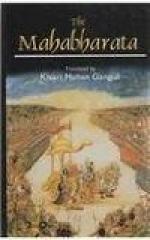all acts by causing their doers to enjoy or endure
their fruits; (or, He that grinds the Destroyer himself)
(DXXXI—DXXXVIII); the great Boar: He
that is understood or apprehended by the aid of the
Vedanta; He that has beautiful troops (in the form
of His worshippers); He that is adorned with golden
armlets; He that is concealed (being knowledge with
the aid of the Upanishads only); He that is deep (in
knowledge and puissance); He that is difficult of access;
He that transcends both word and thought, that is
armed with the discus and the mace (DXXXIX—DXLVII);
the Ordainer; He that is the cause (in the form of
helper of the universe); He that has never been vanquished;
He that is the Island-born Krishna; He that is enduring
(in consequence of His transcending decay): He
that mows all things and is Himself above deterioration;
the Varuna (the deity of the waters); the son of Varuna
(in the form of Vasishtha or Agastya); He that is immovable
as a tree; He that is displayed in His own true form
in the lotus of the heart; He that creates, preserves,
and destroys by only a fiat of the mind (DXLVIII—DLVIII);
He that is possessed of the sixfold attributes (of
sovereignty etc.); He that destroys the sixfold
attributes (at the universal dissolution); He that
is felicity (in consequence of His swelling with all
kinds of prosperity); He that is adorned with the
triumphal garland (called Vaijayanta); He that is armed
with the plough (in allusion to His incarnation as
Valadeva); He that took birth from the womb of Aditi
(in the form of the dwarf that beguiled Vali); He that
is endued with effulgence like unto the Sun’s;
He that endures all pairs of opposites (such as heat
and cold, pleasure and pain, etc.); He that is
the foremost Refuge of all things (DLIX—DLXVIII);
He that is armed with the best of bows (called Saranga);
He that was divested of His battle-axe (by Rama of
Bhrigu’s race);[603] He that is fierce; He that
is the giver of all objects of desire; He that is
so tall as to touch the very heavens with his head
(in allusion to the form He assumed at Valis sacrifice);
He whose vision extends over the entire universe;
He that is Vyasa (who distributed the Vedas); He that
is the Master of speech or all learning; He that has
started into existence without the intervention of
genital organs (DLXVIII—DLXXVI); He that
is hymned with the three (foremost) Samans; He that
is the singer of the Samans; He that is the Extinction
of all worldly attachments (in consequence of His
being the embodiment of Renunciation); He that is
the Medicine; He that is the Physician (who applies
the medicine); He that has ordained the fourth or last
mode of life called renunciation (for enabling His
creatures to attain to emancipation); He that causes
the passions of His worshippers to be quieted (with
a view to give them tranquillity of soul); He that
is contented (in consequence of His utter dissociation
with all worldly objects); He that is the Refuge of
devotion and tranquillity of Soul (DLXXVII—DLXXXV);




